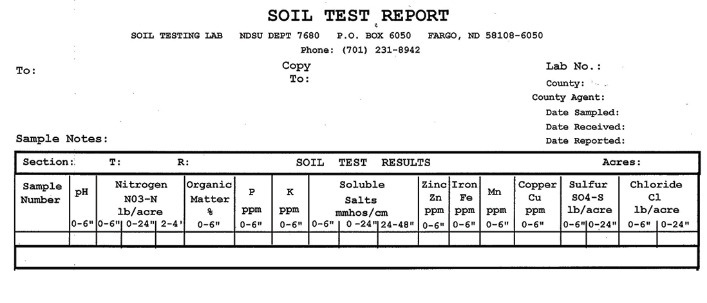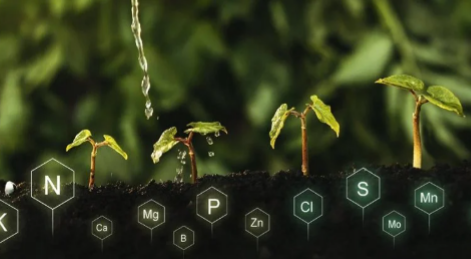
Plant nutrients are elements that are essential for plant growth, reproduction and development. There are about 17 nutrients required by plants. They are divided into two groups, macronutrients and micronutrients. The macronutrients also called major elements are primary elements which include hydrogen (H) , oxygen (O) , carbon (C) , nitrogen (N) , phosphorus (P) , potassium (K) , and the secondary elements include calcium (Ca) , magnesium (Mg) , and sulfur (S) . While the micro or trace or minor nutrients are which include boron (B), chloride (Cl), copper (Cu), iron (Fe), manganese (Mn), molybdenum (Mo), nickel (Ni) and zinc (Zn). The primary elements available in the soil include nitrogen, phosphorus, potassium, calcium, magnesium and sulfur. Those found in air and water include carbon, hydrogen, and oxygen. All these nutrients are essential because without them the plant will not survive and will show deficiency symptom.
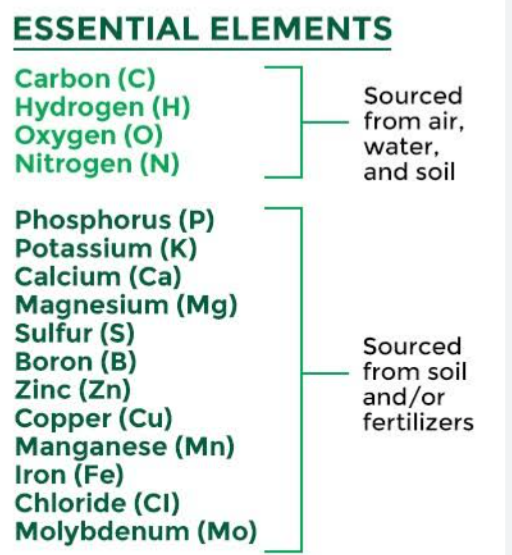
Sources of these nutrients include Organic and inorganic fertilizers. Organic fertilisers include farmyard manure, green manure, compost, vermicompost, urine, knight soil or biosolids. While synthetic or inorganic fertilisers include Urea, N:P:K, Ammonium phosphate, murate of potash, single super phosphate etc.
Excess nutrient or insufficient nutrient in soil has adverse effect on crop production. When nutrients are applied in proper quantities and at the right times, optimum crop yield is achieved. When too little nutrient is applied, yield is limited and applying too much is an economic waste and can pollute the environment. Residual nutrients not utilized by crops are leached into underground water.
When existing soil nutrients are low and cannot produce good crop yields, additional nutrients will be needed. It is important that nutrients applied should not be in excess. Therefore, there is need for proper nutrient management plan for optimization of crop yield.
WHAT IS NUTRIENT MANAGEMENT
Nutrient management involves using crop nutrients as efficiently as possible to improve productivity while protecting the environment. The main principle of nutrient management is balancing soil nutrient inputs with crop requirements. While the primary goal of nutrient management is to prevent accumulation of nutrients on the field to the point that they do not harm or threaten plant growth and the environment. Fertilizers are too costly. Therefore, this brings about a reduction in accumulation of nutrients applied from the source. Animals feed on plants and transform the nutrients in the plants to build their body mass and produce manure. When the manure nutrients are continuously applied to the farm land, it will continue to accumulate until it gets to a level whereby it affects the plant, ground water and surface water negatively. To prevent this nutrient build up, when crops are planted and manure applied, the harvested crops and their residues should be exported from the field.
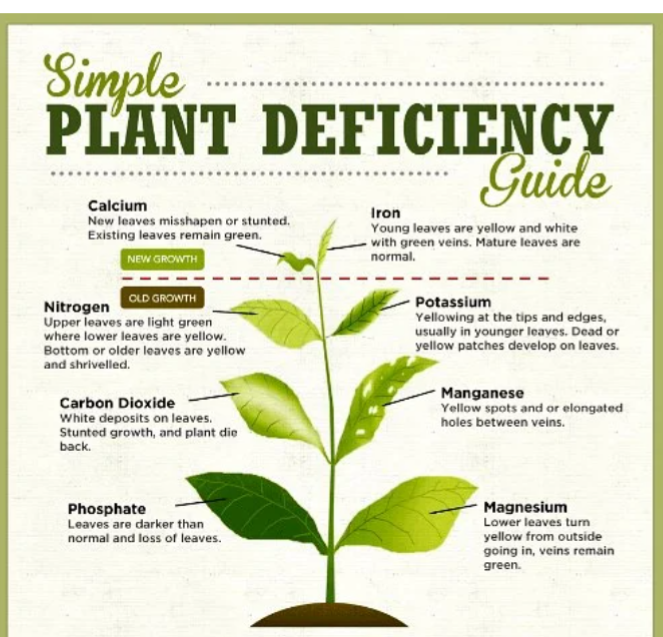
OBJECTIVES OF NUTRIENT MANAGEMENT
The major objectives of soil nutrient management are to;
a. improve soil health
b. meet the nutrient requirements of crops and
c. maintain a safer environment
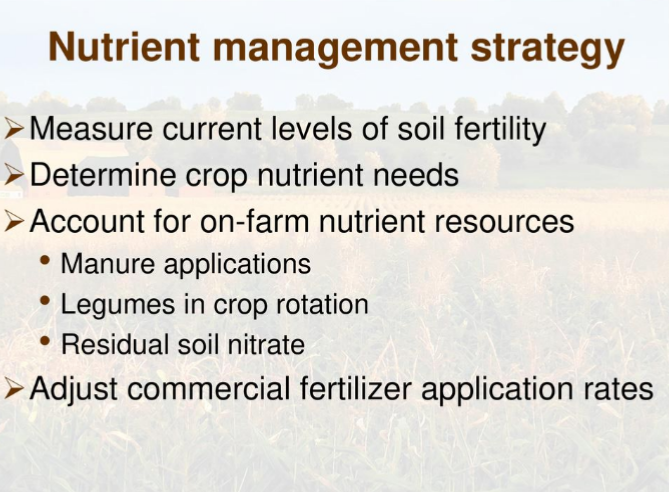
IMPORTANCE OF NUTRIENT MANAGEMENT
Nutrient management is important for the following reasons:
1. Nutrient management helps to reduce contamination of the environment such as surfacewater and underground water.
2. It improve soil health and soil fertility.
3. It maximize nutrient uptake by plant and create environmental safety.
4. It optimize crop productivity.
5. It reduce the cost of investment in farming by utilizing alternative organic fertilizer sources rather than chemical fertilizers.
6. It reduces the wastage of chemical fertilizers by estimating the precise quantity needed to apply per plant.
7. It provides balanced nutrition to crops.
8. Soil test which is the starting point of nutrient management reveals the true condition of the soil before any activities are carried out on the farm. Thus, reduce nutrient wastage
9. Promote carbon sequestration and prevents the deterioration of soil, water, ecology, and also leaching of nutrients from the soil
10. It helps farmers to make appropriate decisions on their farming business
NUTRIENT MANAGEMENT PLAN
All farmers need proper nutrient management planning. This planning is carried out to prevent the over-application of nutrients to crop, protect water quality and minimize the impact of nutrients on the environment while still providing optimum yield for economic benefit. It involves accounting for and recording all the nutrients the farmer has, determining what nutrients he/she would need, and planning how, how much, when and where to apply the nutrients to the crop land. The first step in nutrient management planning is to carry out soil test. This is used to determine what nutrients are in the soil, nutrient requirement per crop, and determining the amount of nutrient required to top up the soil nutrient so as to meet the needs of crops.
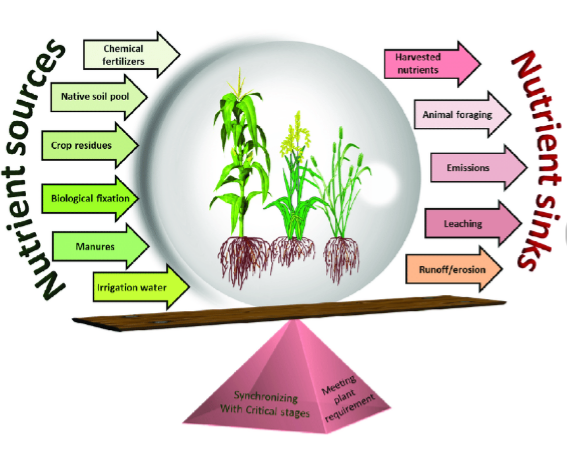
Nutrient management plan helps to define the nutrient needs of crops, how best to provide the nutrient source, placement and timing of application to maximize nutrient uptake by the crop and to improve yield. This will also help in making precise fertilizer application decision for the crops.
A nutrient management plan for manure also called waste utilisation plan is carried out based on the acres of land the manure will be applied on and the type of crop to be grown. This process required is based on two factors:
a. estimating the amount of manure produced and
b. the amount of plant available nutrients in the manure.
Nutrient management plan is usually put in written form before being implemented. A properly implemented plan will assist in nutrient utilisation that will meet crop needs and minimize the nutrients effect on surface water and underground water supplies.
For Implementation of nutrient plan to be successful, there is need for understanding of the information in the management plan, proper use of analytical tools, monitoring information and equipment calibration. All these will bring about an exceptional implementation.
COMPONENTS OF A NUTRIENT MANAGEMENT PLAN
Nutrient management involves the controlling of the amount, source, timing, and technique of nutrient application to maximize agricultural production, reducing nutrient losses and it’s negative effect caused in the environment. There are four components of the nutrient management plan which must be considered to ensure that the nutrients used are in harmony with crop needs and environmental safety. They include:
1. Source
2. Amount
3. Placement
4. Timing
these Four components will assist growers make proper planning that will help maximize the nutrients taken up by a crop and minimize the amount of losses to the environment.
Also, a nutrient management plan will employ best management practices which will help prevent the movement of nutrients from the field through erosion, runoff, crop removal and leaching etc
1. NATURE OF THE SOURCES : When making a nutrient management plan, the source of the nutrients should be put to consideration. Such sources include: the nutrients already available in the soil, synthetic fertilizers, organic manures, crop residues, septage and biosolids. Also legumineous crops that fix nitrogen should be considered.
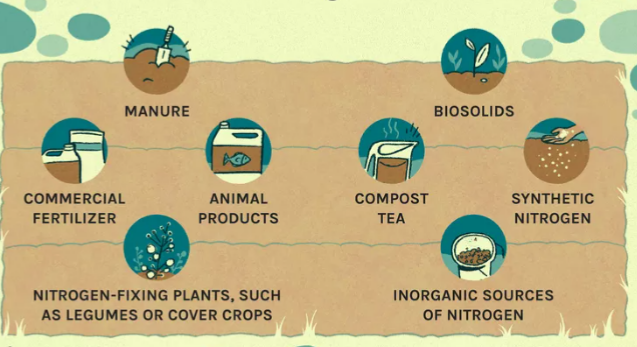
To determine the nutrient content of the different sources, and how readily available the nutrients in the sources are, there is need to carry out a soil and manure analysis. Synthetic fertilizers already carry it’s analysis, only the amount to apply will be estimated.
The availability of nutrients also varies with their sources. For example, synthetic fertilizers contain highly soluble nutrients which are quickly available to plants. Manure and biosolids are of different types. Manures comes from poultry droppings and ruminants dung which are produced from the consumption of different types of feed materials by the animals. Also, green manure comes from different plant sources that contain different amount of nutrients in their tissues. These makes the manure and biosolids to contain varying amount of nutrient content and also the availability of nutrients they contain to vary. These nutrients are released slowly during mineralization of the organic source and some are lost rapidly by volatilization (ammonia).
2. AMOUNT OF NUTRIENTS THAT CAN BE APPLIED SAFELY: The amount of nutrient to apply to a growing crop should be determined by the agronomic rate. The agronomic rate is the amount of the nutrient needed to optimize yield and economic return while minimizing undesirable effects on the environment. Insufficient application of the nutrient result in lower yield, reduced produce quality and decrease the absorption of other plant nutrients. It also produce a visible deficiency symptoms. Excessive application can negatively affect the plant and pollute the environment. For example, too much of nitrogen can reduce crop yield, make plant more susceptible to insect attack and disease infection. It can also increase lodging and stimulate vegetative growth at the expense of fruiting. Also excessive application of nutrients can cause surface water or underground water pollution. Excess of some micronutrient result in heavy metal contamination of the soil and water. Also, excess of some nutrients can result in decrease uptake or unavailability of other nutrients ( antagonistic effect) . For example, High level of nitrogen can inhibit the availability of potassium to crops. High level of phosphate can reduce the uptake of potassium by plant. High level of potash can reduce the availability of Magnesium. Nitrogen and phosphorus in excess can result in Algal blooms, thus, reducing dissolved oxygen in water and causing eventual fish death.
In the case of sources like manure and biosolids, large amount of these nutrient sources are needed to be applied to crops compared to synthetic fertilizers. The amount to be applied should be based on priority nutrient (which is the nutrient most likely to have negative effect on crop yield and the environment). This gives reason why soil fertility levels should be monitored so as to ensure that excessive nutrients do not become a problem.
For most crops, agronomic rates are determined by the realistic yield expectation(R. Y. E) of the site and the amount of nitrogen required to produce a unit of a crop.
REALISTIC YIELD EXPECTATION
Realistic yield expectation is important for good nutrient management and prevention of nitrate from contaminating groundwater.
Realistic yield expectation is affected by a number of factors. One of which is the soil. Some of the soil related factors that affect yield include:
Organic matter content, permeability (infiltration and runoff), texture of surface soil, water holding capacity, depth of rock or root confining zones, subsoil depth, drainage, mineralogy, slope, soil structure, local climate ( drought, soil temperature, excessive water). Other factors affecting realistic yield expectation include agricultural practices, pest and diseases, climatic condition, etc
3. PLACEMENT OF NUTRIENTS ON THE FIELD
Placement of nutrients affect it’s uptake by crop and movement away from the site as a result of runoff and erosion. Nutrients sources like urea and ammonium application to soil surface without incorporating them into the soil result in greater loss through volatilization, runoff,and erosion. Uniform or distance application from the root system can prevent burning of the plant. The method of application can also affect odour emission associated with animal manure if not properly cured. Surface application should be accompanied with irrigation to prevent losses of the nutrients. Some placement methods include plough sole, localised, deep placement, drilling and band placement etc.
4. TIMING OF NUTRIENT APPLICATION
All nutrients applied should be timed so that it maximise crop yield and minimize possible losses. Timing applications properly also ensures that nutrients are available during peak periods of plant uptake and are in adequate supply at critical stages of development in the crop. In general, nutrients should be applied to an actively growing crop or within 30 days of planting a crop. Timing is most important for nutrient applied to soil with a high leaching potential to prevent losses. For example, nutrients applied to sandy soils without any crop growing on it to remove the nutrients will result in losses caused by leaching to underground water. This pollute the water and can cause health risk if drank by human or other animals.
SOIL TEST
Soil test is very important when carrying out nutrient management plan. Soil test is used to determine or estimate crop nutrient requirements which is a key focus point for creating a nutrient management plan. Soil samples collected from the field are sent to the soil laboratory for analysis. The results from the soil tests will determine which management practices and soil amendments will be employed to increase crop yield and profitability. The soil test will also give a true account of the deficient nutrient as visual deficiency symptoms may not be relied upon due to the fact that different nutrients show similar deficiency symptoms. For instance, nitrogen (N) and sulfur (S) show yellowish deficiency symptom on leaves. But where the deficiency symptoms start showing, whether on the older leaves or newer ones makes a different. Also, the soil test result can provide other information concerning the soil condition, such as water holding capacity, soil texture and soil pH etc.
